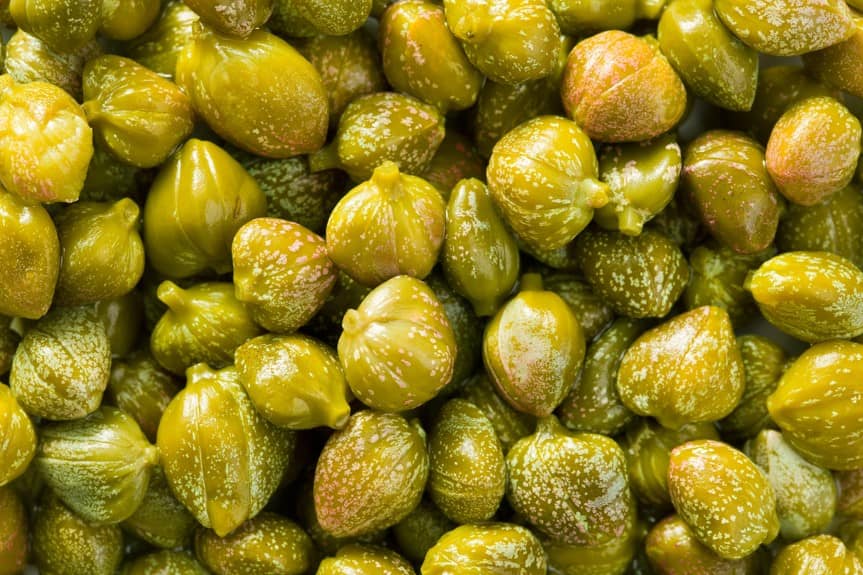This post may contain affiliate sales links. Please read my disclosure policy.

If you’ve ever tasted capers, I’m pretty sure you know them for their distinctive tangy, briny flavor. They have a certain way of slipping quietly into a dish and making a significant impact, don’t they?
I still remember the first time I encountered capers. It was on a slice of smoked salmon pizza. I was intrigued by these peculiar green garnishes, perfectly nestled amidst the salmon and cream cheese.
With just one bite, my palate was taken aback by a burst of flavor. It was a delightful blend of saltiness and a mild, refreshing tartness that beautifully complimented the richness of the salmon.
It was at that moment I fell head over heels for these fascinating buds and began my culinary adventure into the world of capers.
So, what exactly are capers, where do they come from, and how can you use them in your cooking?
What Are Capers?
Capers are unopened flower buds harvested from a prickly, perennial plant that belongs to the Capparaceae family (Yeah! Don’t worry if you can’t pronounce it, neither can I).
They are native to the Mediterranean region and some parts of Asia, where the warm and arid climate provides an ideal environment for their growth.
These small, green buds are a staple in Mediterranean cuisine. When harvested, capers are about the size of a corn kernel or a pea, though they can vary.
Once picked, they don’t end up directly on your plate. Instead, they go through a curing process that involves drying and brining, or sometimes packing in salt.
This process gives capers their distinctive punchy, tangy, and slightly lemony flavor.
Nutritional Benefits and Health Claims
Essential Nutrients Found in Capers
When you look at a caper, it’s easy to underestimate it. I mean, how much nutrition can these petite, puckered pods possibly pack?
The answer is: quite a bit.
Capers contain Vitamin K, which is crucial for your bone health and proper blood clotting. They’re also a good source of Vitamin A, promoting good vision and immune function. Not to mention, they have trace amounts of other nutrients like Vitamin E, niacin, riboflavin, and more.
In addition to vitamins and antioxidants, capers also contain minerals like calcium, iron, magnesium, zinc and potassium.
And for those looking for a tasty way to boost their fiber intake or reduce their calorie intake, they will be happy to know that capers are a low-calorie food and are high in fiber.
Potential Health Benefits of Capers
Rich in Antioxidants
Capers are packed with antioxidant compounds, which help protect your body against damage from harmful molecules called free radicals.
When free radicals accumulate, they can cause a state known as oxidative stress, which is linked to chronic diseases such as heart disease, cancer, and many others. By providing antioxidants, capers may help your body combat this oxidative stress.
Anti-Inflammatory Properties
The flavonoids in capers also exhibit anti-inflammatory effects.
Inflammation is your body’s natural response to injury or illness, but chronic inflammation can cause diseases like arthritis, diabetes, and even depression.
Incorporating foods with anti-inflammatory properties, such as capers, may help manage this.
Bone Health
Capers are a good source of vitamin K, which plays an important role in bone health. Vitamin K is involved in bone mineralization, a process that helps maintain the strength and density of bones. Consuming adequate vitamin K can help protect against osteoporosis and fractures.
Digestive Health
Capers contain a good amount of fiber, which is beneficial for digestive health. Dietary fiber can help prevent constipation, making your digestive system more efficient. Plus, it could contribute to weight management, as fiber-rich foods tend to make you feel fuller and curb overeating.
Heart Health
Thanks to their fiber content, capers could also support heart health. Fiber can help lower levels of LDL cholesterol, the “bad” cholesterol that can build up in your arteries and lead to heart disease.
Culinary Uses and Pairings
I find that capers are like little flavor-packed gems, adding a unique touch to a myriad of dishes. Their distinct tangy and salty flavor has earned them a spot in various recipes around the world, notably in Mediterranean cuisine.
Some of the common dishes that include capers range from Italian Pasta Puttanesca, where capers mingle beautifully with olives and anchovies, to Chicken Piccata, where they add a kick to the tangy lemon sauce.
Even salmon and capers make for a lovely duo, with the capers cutting through the richness of the fish.
And moving on to other dishes, the bold taste of capers lends itself beautifully to salads, providing an unexpected flavor punch, or to dips like tapenade or salsa verde, where they are mashed into the mix.
I personally love the little salty explosions they add to a New York-style bagel loaded with lox and cream cheese.
But what do capers pair well with, you may ask?
Their bold flavor finds companions in a variety of ingredients. They complement the flavors of meats like chicken and lamb perfectly. When it comes to veggies, think along the lines of tomatoes, bell peppers, cucumbers, and artichokes.
Capers also harmonize well with cheeses, particularly feta, cream cheese, and mozzarella, and they’re a refreshing addition to grain-based salads.
As for herbs and spices, you can’t go wrong with dill, basil, mint, or garlic.
Tip: Sometimes, I’ve found capers to be a bit too intense in flavor. If you encounter this, a handy trick is to soak them in cold water for about 20 minutes. This helps mellow their tang and can make them more palatable for those not accustomed to their robust taste.
Storage and Preservation Methods
When it comes to storing and preserving capers, I’ve found a few strategies that work best to keep them fresh and flavorful.
It’s important for you to understand these methods, as they will ensure your capers remain ready to use whenever the mood strikes.
For jarred capers, which are typically pickled in brine, I advise storing them in the refrigerator after opening. Keep the capers submerged in their original liquid to maintain their piquant flavor.
From my experience, they tend to keep up to a year this way. However, you should always be mindful of the best-before date and regularly check for any signs of spoilage, such as off odors or the presence of mold.
If you prefer using salt-packed capers, a favorite among gourmet cooks and certainly a personal preference of mine due to their superior flavor, there’s a slightly different storage method.
After each use, make sure to press the remaining capers down into the salt to keep them well preserved. Store the container in a cool, dark place to maintain their freshness.
In Summary
As you experiment with capers in your cooking, you’ll see how they enhance flavors and textures. Their tangy, salty, and slightly herbal notes lift and complement other tastes in a dish, providing a perfect contrast to rich, fatty foods.
Their delightful crunch adds an extra layer of texture, making a dish more complex and enjoyable.
But, remember, capers are potent, and while I am a fan, you might want to start small, adding more as your taste buds become familiar with their intensity.
That said, feel free to play around and experiment, find the balance that works for your palate, and enjoy the zest that capers bring to your culinary creations.




